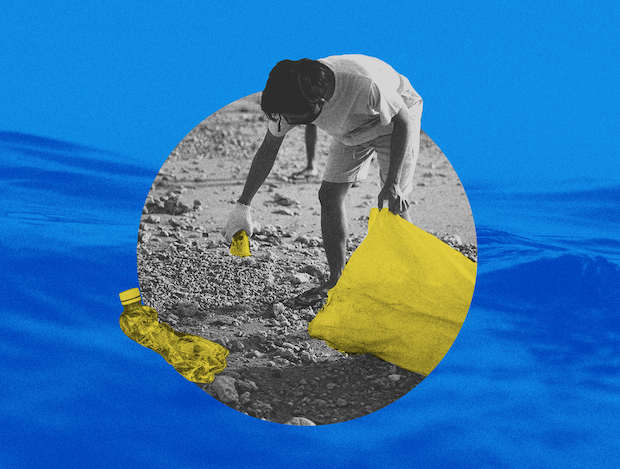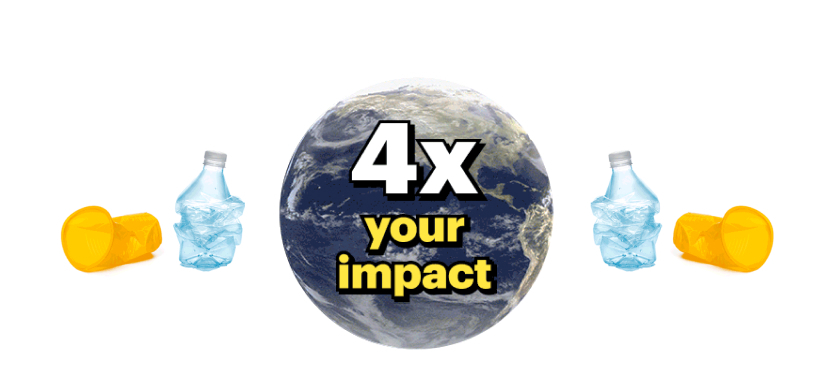The 3 Worst Ways Plastic Threatens People and Planet
Published Aug 23, 2023

Our plastic crisis endangers our environment, our climate, and our health. But we won’t stop it just by changing our habits.
Growing up, my mom taught me to cut the plastic rings around soda cans so that, if they ended up in waterways, they wouldn’t entangle fish. It’s a habit I continue doing to this day. But through my work at Food & Water Watch, I’m learning that our plastic pollution crisis is much bigger than that.
Plastic’s harms have grown beyond strangling sea creatures or filling our gutters and landfills. Its pollution now touches every corner of the Earth and every corner of our lives. And the crisis is closely connected with so many others — including climate change.
Here are the three worst ways plastic wreaks havoc on our planet and how we can stop it.
1. Plastic Production Fuels Extreme Heat and Other Kinds of Climate Chaos
Our planet is baking this summer. The Atlantic Ocean is nearing bathwater temperatures. Folks are getting third-degree burns from falling on asphalt. July smashed the record for the hottest month on this planet in recorded history. As the scientists tell it, we are entering a new climate era.
So what does plastic have to do with it?
The very same fossil fuels creating these climate-fueled conditions are also key ingredients in plastic. Nearly all of U.S. plastic comes from fracking byproducts.
The fracking boom has made plastic cheaper and more abundant on our planet already plagued by plastic pollution. And the plastic boom has created new markets into which fossil fuels will flow, incentivizing more fossil fuel production.
More fossil fuels means more plastic; more plastic means more fossil fuels — and all the devastating pollution and climate emissions that come with them.
2. Microplastics Are Making Us Sick
Thanks to this excess of plastic products and packaging, plastic is entering our food, water, and bodies. As plastic ages, wears down, and even just changes temperature, it can fragment and shed little bits. These microplastics are less than 5 mm in length.
Synthetic carpets shed them into the air; containers leach them into our food. As a result, we’re breathing, drinking, and eating microplastics all the time. We consume an estimated credit card’s worth of plastic every week.
Moreover, researchers have found that microplastic pollution can contaminate the soil and travel through the crops we grow for food.
This is all especially concerning because of the toxic additives that companies add to plastic. Many aren’t well-studied, build up in our bodies, and/or become dangerous in large enough amounts.
Some plastic additives have been found to cause cancer or disrupt hormones. That includes PFAS forever chemicals, which companies add to their products to make them stain- or water-resistant.
Researchers are just starting to understand all the ways plastics get into our bodies and the havoc they wreak when they get there.
Learn more about how microplastics have infiltrated our food, environment, and bodies in our recent fact sheet, “Food for Thought: Microplastics Are a Macroproblem.”
3. Plastic Pollution Endangers the Natural World
We know by now that plastic pollution poses a huge threat to ocean life. But those threats go beyond plastic rings entangling fish and straws stuck in turtles’ noses.
Animals are also eating plastic. For instance, many turtles are eating plastic bags, mistaking them for the jellyfish they usually dine on. As plastics accumulate in their stomach, sea animals may feel full without having any nutrition, so they starve to death.
If plastic’s toxic additives are bad for us, you can imagine how bad they are for marine life. Plastic pollution has been linked to liver toxicity, embryo deaths, and impaired cell function in different sea animals.
Moreover, the microplastics floating in the ocean can accumulate and carry all sorts of things, like chemical pollution, heavy metals, and even diseases.
Plastic also disrupts important processes that help keep the planet functioning. For example, plankton on the ocean’s surface pull carbon from the atmosphere through photosynthesis. When fish eat the plankton during the day and return to the ocean floor at night, they excrete the waste, storing the carbon in the deep sea.
These kinds of cycles are responsible for bringing 10 billion tons of carbon from the surface to the depths of the ocean each year. They’re key to keeping a whole lot of carbon out of the atmosphere. But fish eating microplastics instead of plankton threatens this delicate cycle.
The Real Solution: Ending Fossil Fuels
Plastics are everywhere. As much as you and I try, it’s impossible to cut them out completely.
This planetary plastic pile-up exists in part because powerful corporations have hidden plastic’s dangers from us. And in doing so, they’ve chosen quick profits and pollution over the well-being of planet and people.
What’s more, corporations have blamed us for the problem — even though 40% of plastic made becomes packaging, something we as consumers have little say in. And they’ve misled us toward individual “solutions” like recycling, picking up litter, and cutting the rings around soda cans.
That’s because plastic is lucrative for fossil fuel corporations and cheap for manufacturers. They know the true solutions threaten their bottom line.
To fight our plastic pollution crisis, we need to cut production at the root and end fossil fuels. That will help us take on our intertwined public health, environmental, and climate crises, too.
We shouldn’t have to be afraid of the food we eat or the water we drink. And we all deserve a livable planet, right now and for future generations. That’s why Food & Water Watch is working to fight plastic pollution at the source by banning fracking and stopping fossil fuel infrastructure.
Together, we can break free from plastics and protect our food, water, and climate.
Triple your impact! Your gift will be matched $2 to $1, including monthly gifts till the end of the year.

Time to face it —~it’s people or plastics.~We can’t have both.
Become a plastic pollution fighter this Earth~ Day and have your gift MATCHED $3-to-$1!
Enjoyed this article?
Sign up for updates.
TO TOP


